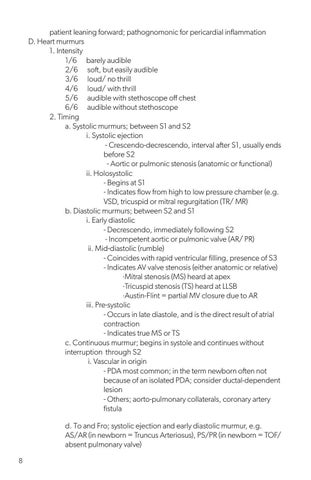patient leaning forward; pathognomonic for pericardial inflammation D. Heart murmurs 1. Intensity 1/6 barely audible 2/6 soft, but easily audible 3/6 loud/ no thrill 4/6 loud/ with thrill 5/6 audible with stethoscope off chest 6/6 audible without stethoscope 2. Timing a. Systolic murmurs; between S1 and S2 i. Systolic ejection - Crescendo-decrescendo, interval after S1, usually ends before S2 - Aortic or pulmonic stenosis (anatomic or functional) ii. Holosystolic - Begins at S1 - Indicates flow from high to low pressure chamber (e.g. VSD, tricuspid or mitral regurgitation (TR/ MR) b. Diastolic murmurs; between S2 and S1 i. Early diastolic - Decrescendo, immediately following S2 - Incompetent aortic or pulmonic valve (AR/ PR) ii. Mid-diastolic (rumble) - Coincides with rapid ventricular filling, presence of S3 - Indicates AV valve stenosis (either anatomic or relative) ·Mitral stenosis (MS) heard at apex ·Tricuspid stenosis (TS) heard at LLSB ·Austin-Flint = partial MV closure due to AR iii. Pre-systolic - Occurs in late diastole, and is the direct result of atrial contraction - Indicates true MS or TS c. Continuous murmur; begins in systole and continues without interruption through S2 i. Vascular in origin - PDA most common; in the term newborn often not because of an isolated PDA; consider ductal-dependent lesion - Others; aorto-pulmonary collaterals, coronary artery fistula 8
d. To and Fro; systolic ejection and early diastolic murmur, e.g. AS/AR (in newborn = Truncus Arteriosus), PS/PR (in newborn = TOF/ absent pulmonary valve)


